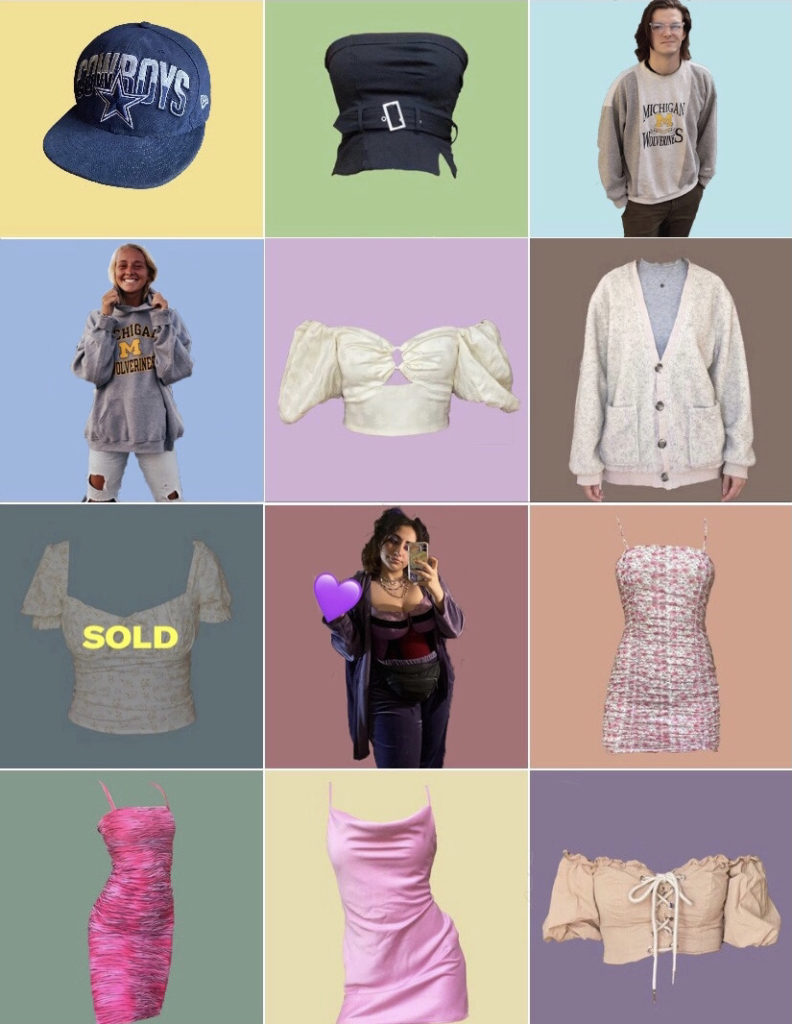The Nature of the Thrift
Where fashion and sustainability and Tik Tok meet
—By Katherina Andrade Ozaetta
When did everyone get so into thrifting?
Thrifting is For You
Scrolling through my TikTok, the zeitgeist of Generation-Z culture, the majority of my For You Page has been flooded with thrifting videos. I feel like I’ve seen all the thrifting Tik Toks possible at this point. A middle schooler explaining how her outfits of the day are sourced from Goodwill. A college student’s clothing hauls showcasing the latest finds from Salvation Army. A high schooler explaining how shopping second-hand helps the environment while creating a unique killer wardrobe. Interspersed throughout these videos are lip-syncs and comedy bits, and while watching, I couldn’t stop thinking about how much I wanted to go thrifting.
Back in the ‘90s, my mom would go to Value World in Ypsilanti, Mich., with her college friends to look for Levi’s. Now, decades after my mom, LSA sophomore Rita Sayegh visits that same Value World with her friends. Now, it’s not surprising to hear of high school and college students thrifting on the weekends, but it was at one point. In the late 90s to the mid-2000s, fast-fashion labels dominated the fashion industry. Hedonistic consumption of clothing was at its peak; Zara, H&M, Forever 21 and more were more than willing to feed societal haste. These brands are the pinnacle of fast fashion, because Zara, H&M and Forever 21 provide the latest trends off the runway in a cheap, quick manner. However, the trend began to shift as Gen Z grew older. A Deloitte study on individuals born between 1995-2012 (Gen Z) theorized that the Great Recession shaped the age group to become more focused on financial security and pragmatic about finances and as a result, willing to shop at thrift stores to score clothing goods at a better price. Others have reasoned that the rise of social media has normalized and popularized secondhand clothing as seen through its prevalence on social media apps. Some speculate that the growing climate crisis has forced Gen Z to look more critically at their carbon footprint and refrain from supporting fast fashion and its terrible impact on the environment.
Fast Fashion and Lasting Issues

Thrift shops have provided college and high school students with new opportunities in fashion. One of these opportunities is to create a more intentional lifestyle that minimizes the impact on the environment. For LSA sophomore Brendan Bontrager, shopping at the Salvation Army started out as a way to find pieces for a Halloween costume or a themed party. Bontrager didn’t consider thrifting as a resource for his actual wardrobe. That began to change in college when he became aware of the nature of fast fashion.
“I used to think of environmental harm as oil companies,” Bontrager said. “But I became aware of how fast fashion harms the environment (and) how H&M has unethical working conditions.”
As Bontrager discusses, fast fashion creates various societal and ethical issues. Due to its cheap prices, clothing factories cut corners to keep manufacturing cheap, underpaying workers and creating hazardous work environments. However, the harm does not stop there. Fast fashion has also fed into the climate crisis. According to the World Resources Institute, textile production releases around 1.2 billion tons of carbon dioxide into the atmosphere per year, which is linked to global warming and is responsible for 10% of total global emissions.
These issues forced Bontrager to look toward other clothing options, but, like many, he ran into the issue of cost. Retailers like Patagonia, Reformation and Boden create clothing with minimal environmental impact and ethical labor conditions, but it comes at a steep cost to the consumer. For high school and college students, these costs can be a deterrent for shopping sustainably. Bontrager realized that he could turn to the Salvation Army or Goodfair, an online thrift store retailer, for his clothing needs without forgoing his passion for sustainability.
Youtube Girls

In Sayegh’s case, she developed this interest in thrifting through her love of YouTube. Sayegh said that in her childhood she watched a lot of YouTube and she “would see the YouTube girls thrifting all the time,” referring to creators like Liza Koshy, Emma Chamberlain, Hannah Meloche, Ashley Rous and others that began posting videos centered around thrifting about three years ago. The most popular video, “THRIFTING BRANDS!! GOODWILL WITH GREATLIZA,” from Liza Koshy has about 15.4 million views. Comparatively, the most popular clothing haul videos centered around Zara, H&M and Forever 21 have barely half as many views as many of the thrift haul videos — the most popular Zara haul video amassing only 3.1 million views. Thrifting became more mainstream as a result of young viewers watching their favorite internet personalities finding great pieces of clothing for cheap prices.
The change in attitude was noticeable for LSA sophomore Abigail Miars, the owner of the clothing resale store Umich Apparel. Growing up in Grand Rapids, Mich., Miars frequently went with her father to garage sales and began shopping at thrift stores in 2014, but she never felt comfortable attributing her wardrobe to thrift stores until recently.
“A couple years back, (thrift stores had) a negative connotation that you couldn’t afford (new) clothes if you shopped at the Salvation Army,” Miars said.
But around two years ago, Miars realized that the conversation surrounding thrifting began to skew more positively and has grown into a massive industry of its own.
Do the Hustle
The resale industry has been growing rapidly. In 2019, it was estimated that the industry was worth $24 billion, outpacing traditional retail stores in growth over the years. At the center of this growth are students. Young adults have begun reselling clothing as a side hustle, an avenue worth pursuing for extra money. These students will come into thrift stores and buy in bulk. Then, they will “flip” the clothing by customizing their thrift finds, a process in which they crop the shirt or dye it or sew it into different articles of clothing entirely. Then, they typically post the clothes on a special Instagram account or a resale app like Poshmark or Depop to sell it.
This thrift flipping is a model that Miars follows with her store Umich Apparel, where she sells thrifted University of Michigan gear that she sometimes customizes herself. Miars found herself unsure of what to wear on game days. Places like the MDen and Verbena charge high prices for U-M apparel; but students with the means to do so are willing to pay because there aren’t other options readily available.
Miars said in describing the formations of her store, Miars reveals that she herself had no Michigan clothing. Miars realized that she could fulfill this need while also fulfilling a passion of hers in the process. She began her store on Instagram, which currently has 2,300 followers, posting photos of thrift finds with suggested prices at the bottom. Customers directly message her through the platform to purchase the clothing.
Gentrifying the Salvation Army
Though thrifting has provided many benefits to shoppers, a new issue lurks on the horizon: the Depop seller. These sellers buy in bulk from thrift stores and sell these pieces on resale apps for extreme markups of over 300 times the original price.
“It makes it harder for people to shop second hand online if they don’t have access to thrift stores,” Sayegh lamented.
Miars also said this prevents people from experimenting with fashion through thrifting.
“In situations like that really unique pieces become inaccessible to the everyday buyer,” Miars said.
For instance, a seller could purchase a children’s Hello Kitty top for $2 at the Salvation Army. They then customize it by cutting around an inch off the hem of the shirt and sewing a new hem on the bottom of the shirt. Finally, they post the piece on Depop for $70, making the shirt inaccessible to many potential buyers who would otherwise be interested in it.
But at what point does business savvy translate to predatory, unethical pricing? Some thrift stores have caught on, realizing that they can charge more for their clothing. This causes thrift shop prices to rise, pricing out families that are financially dependent on the stores. For instance, Goodwill in its annual valuation guide changed its pricing strategy from a fixed price of $4 to a range from $2-12.
To counteract this, activists have turned to TikTok to promote ethical thrifting with guidelines of what to buy and how to shop to protect families that are dependent on these shops. In a video created by @curli_fries, she outlines how thrift shoppers can shop ethically. For instance, if a shopper has access to a car, they should try to shop in higher-income areas, where these stores are potentially less frequented. In a YouTube video from Sarah Hawkinson, she stresses the importance of refraining from buying in bulk, as it ultimately limits options for individuals that rely on these stores and can prevent them from purchasing the clothing they need. It also continues the vicious cycle that fast fashion propagates: the quick use and thedonating/selling/discarding of clothing after only a few wears. Practices like these allow for ethical thrift shopping and can help prevent thrift store gentrification.
Turning Back to TikTok
As of Sunday, the hashtag for thrifting has over 1.1 billion views on TikTok. There are hundreds of thousands of videos posted under this hashtag, gaining millions of views, likes and comments. The trend is clearly here to stay, but how Gen-Z will incorporate it in the future remains to be seen. For Miars, this means looking to the future with her shop, knowing that it will be a hard hustle to maintain atop a full-time job.
“I thought about selling the shop when I’m a senior,” Miars says nostalgically. “Putting together a pitch and passing it on.”
Miars also dreams of pivoting the Instagram-based shop into a real store like Plato’s Closet, where girls can come in and be able to shop second hand in person. The future of Umich Apparel remains unclear, but hopefully it will remain as bright and unique as it does now. Similarly, the societal shift toward sustainable clothing, recycling and remodeling is a hopeful pursuit, but we must hold one another accountable to ensure we don’t deter the accessibility and affordability that is at the very root of thrifting culture.
Feature Photo By Katherina Andrade Ozaetta

